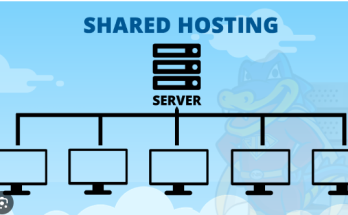Introduction (150 words)
- Start with a brief overview of web hosting and its importance for websites.
- Introduce Bluehost as a reputable web hosting provider with a strong reputation in the industry.
- Set the tone for the article and outline what readers can expect to learn.
1. Company Overview (200 words)
- History of Bluehost: Founding, milestones, and growth.
- Emphasize Bluehost’s position as one of the leading web hosting providers.
- Mention any awards, recognitions, or partnerships that highlight their credibility.
2. Features and Services (500 words)
- Detailed breakdown of Bluehost’s key features: storage, bandwidth, uptime, etc.
- Explore the various hosting plans (shared, VPS, dedicated) and their suitability for different website needs.
- Discuss additional services offered (domain registration, SSL certificates, site builders, etc.).
3. User Experience and Interface (300 words)
- User-friendly interface: Discuss Bluehost’s control panel (cPanel) and its ease of use.
- Highlight user experience through customer reviews and testimonials.
- Mention any unique tools or features that enhance the user experience.
4. Performance and Reliability (400 words)
- Uptime statistics and server reliability.
- Page loading speed and performance benchmarks.
- Any advanced technologies or features that contribute to superior performance.
5. Customer Support (300 words)
- Availability of customer support: live chat, phone, ticket system, etc.
- Response times and quality of assistance provided by Bluehost’s support team.
- Include anecdotes or customer experiences to illustrate the support quality.
6. Pricing and Plans (350 words)
- Breakdown of pricing structures and different hosting plans offered by Bluehost.
- Highlight any discounts, promotional offers, or money-back guarantees.
- Compare the value offered with the pricing tiers.
7. Security Measures (250 words)
- Discuss Bluehost’s security protocols and measures against common online threats.
- SSL certificates, backups, malware scanning, and other security features.
- How Bluehost ensures the safety of hosted websites and customer data.
8. Pros and Cons (200 words)
- Summarize the advantages and drawbacks of using Bluehost.
- Be objective in presenting both sides to give readers a balanced view.
Conclusion (150 words)
- Recap the main points discussed in the article.
- Emphasize the strengths that make Bluehost a reliable choice for web hosting.
- Encourage readers to consider their specific website needs before choosing a hosting provider.
Title: The Ultimate Guide to Bluehost Web Hosting: Unveiling Its Features, Benefits, and How to Get Started
Introduction:
- Brief overview of web hosting and its importance for websites.
- Introduction to Bluehost as a prominent web hosting provider.
- Purpose of the article – to explore Bluehost’s features, advantages, and how to begin using it.
Section 1: Understanding Bluehost
- Company Overview
- Bluehost’s history, establishment, and growth.
- Notable milestones and achievements.
- Services Offered
- Overview of hosting plans offered by Bluehost (Shared, VPS, Dedicated, WordPress, etc.).
- Highlighting the key features of each hosting plan.
- Benefits of Choosing Bluehost
- Reliability, uptime, and speed.
- Scalability and flexibility for different website sizes.
- Customer support and user-friendly interface.
Section 2: Bluehost Features in Detail
Performance and Uptime
- Explanation of Bluehost’s infrastructure and technology.
- Details on uptime guarantees and server performance.
Ease of Use
- Walkthrough of Bluehost’s user interface (cPanel).
- Simplified website setup and management.
Security Measures
- Overview of Bluehost’s security protocols and features.
- SSL certificates, automatic backups, and malware detection.
WordPress Integration
- Bluehost’s partnership and optimization for WordPress hosting.
- Specific features tailored for WordPress users.
Section 3: Getting Started with Bluehost
Signing Up for Bluehost
- Step-by-step guide on creating an account.
- Choosing the right hosting plan for specific needs.
Domain Registration and Management
- Registering a domain through Bluehost.
- Managing domains within the Bluehost dashboard.
Setting Up a Website
- Installing WordPress or other CMS via Bluehost’s one-click installation.
- Customizing website settings and themes.
Optimizing Performance
- Utilizing Bluehost’s performance-enhancing features.
- Tips for optimizing website speed and efficiency.
Conclusion:
- Recap of Bluehost’s key features and benefits.
- Encouragement for readers to explore and leverage Bluehost for their web hosting needs.
- Call-to-action for signing up or exploring further resources on Bluehost’s website.
Understanding Bluehost Web Hosting: A Comprehensive Guide
Introduction to Bluehost:
Bluehost is one of the leading web hosting providers, renowned for its user-friendly interface, reliability, and excellent customer support. In this guide, we’ll explore the step-by-step process of setting up a website using Bluehost.
Step 1: Signing Up for Bluehost
- Visit Bluehost’s Website: Navigate to Bluehost’s official website.
- Choose a Plan: Select a hosting plan that suits your needs (Shared, VPS, Dedicated, etc.).
- Register a Domain: Either register a new domain or use an existing one.
- Complete the Payment: Enter billing details and complete the payment process.
Step 2: Accessing Bluehost Control Panel (cPanel)
- Login to Your Bluehost Account: Use the credentials provided during signup.
- Access cPanel: Bluehost’s cPanel is user-friendly and provides access to various tools for website management.
Step 3: Installing WordPress on Bluehost
- Locate the Website Builder: In cPanel, find the ‘Website’ or ‘WordPress’ section.
- Click on WordPress: Bluehost offers a simple WordPress installation process.
- Set Up Your WordPress Site: Enter site details like site name, username, and password.
Step 4: Managing Your Website on Bluehost
- Customizing Your Website: Access the WordPress dashboard to choose themes, plugins, and customize the design.
- Managing Files: Use the File Manager in cPanel to upload, edit, or delete website files.
- Setting up Emails: Create professional email addresses associated with your domain.
Step 5: Enhancing Security on Bluehost
- SSL Certificate: Enable SSL for a secure connection. Bluehost provides free SSL certificates.
- Backup Your Website: Use Bluehost’s backup tools or plugins to regularly backup your website’s data.
- Utilize Security Plugins: Install and configure security plugins to safeguard against threats.
Step 6: Optimizing Performance
- Content Delivery Network (CDN): Utilize Bluehost’s CDN or integrate third-party CDNs for faster content delivery.
- Caching: Enable caching to improve website loading times.
- Optimize Images: Compress and optimize images to reduce page load times.
Step 7: Utilizing Bluehost Support and Resources
- Knowledge Base and Tutorials: Explore Bluehost’s resources for guides, FAQs, and tutorials.
- Customer Support: Contact Bluehost’s support team for any technical assistance or queries.
Conclusion:
Bluehost offers a robust platform for hosting websites with its user-friendly interface, powerful features, and reliable service. By following these steps, you can efficiently set up and manage your website using Bluehost.
Title: The Comprehensive Guide to Bluehost Web Hosting
Introduction (150-200 words)
- Define the importance of a reliable web hosting service.
- Briefly introduce Bluehost and its significance in the hosting industry.
- Mention the intent of the article—to explore Bluehost’s features, benefits, pricing, and user experience.
Section 1: Understanding Bluehost (300-400 words)
- Bluehost’s history and establishment in the web hosting market.
- Overview of the services they offer: shared hosting, VPS hosting, dedicated hosting, and WordPress hosting.
- Emphasize their focus on user-friendly solutions and customer support.
Section 2: Features and Tools (500-600 words)
- Detail the key features offered by Bluehost, such as:
- Control Panel (cPanel) functionalities.
- One-click installations for popular CMS platforms (WordPress, Joomla, Drupal).
- SSL certificates and website security.
- Scalability options and resources like bandwidth and storage.
- Email hosting and management tools.
Section 3: Performance and Reliability (400-500 words)
- Discuss Bluehost’s uptime guarantees and server reliability.
- Highlight the performance benchmarks, including speed tests and server response times.
- User reviews or testimonials to support claims about its reliability.
Section 4: User Experience and Support (400-500 words)
- User interface walkthrough—how easy it is to navigate Bluehost’s dashboard.
- Customer support options (live chat, phone, ticket system) and their responsiveness.
- Highlight any unique support features or resources provided by Bluehost.
Section 5: Pricing and Plans (400-500 words)
- Detailed breakdown of Bluehost’s pricing structure across different hosting plans.
- Compare features and pricing tiers to help readers make informed decisions.
- Include any discounts, offers, or money-back guarantees.
Conclusion (150-200 words)
- Summarize the key points discussed in the article.
- Reiterate why Bluehost stands out among other hosting providers.
- Encourage readers to take action, sign up, or explore further based on their hosting needs.



